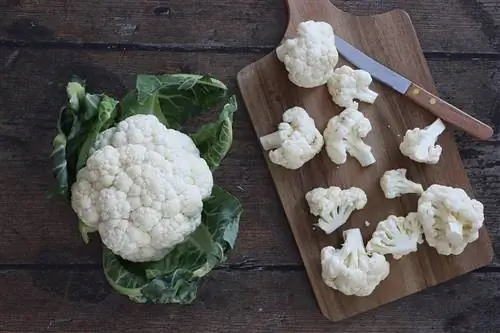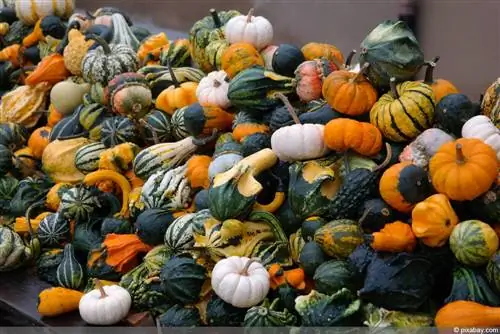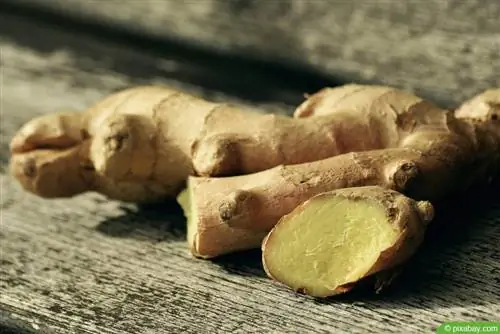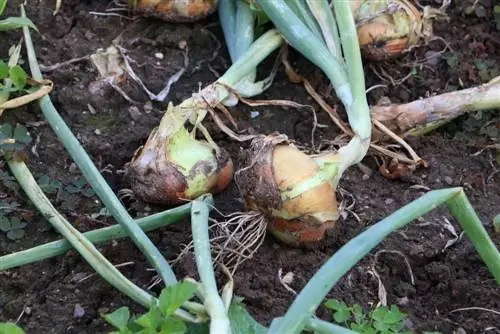- Author admin [email protected].
- Public 2023-12-17 03:39.
- Last modified 2025-06-01 06:48.
Anyone who grows their own vegetables in the garden faces a so-called cauliflower glut in early August to late September. To ensure that your efforts are not in vain, the surplus must be stored properly for a longer shelf life. But how long does cauliflower stay fresh and how can its lifespan be extended?
Cauliflower - interesting facts about vegetables
In addition to its fine taste, cauliflower impresses with its high content of vitamin B and vitamin C. It also provides us with numerous minerals such as phosphorus, potassium, calcium and magnesium. In this country, the high season runs from June to October. The vegetables can be harvested after a short growth period of 8 to 12 weeks. In any case, you should harvest before the florets open. The entire head is removed with a knife. The plant remains must then be lifted out of the ground.
Characteristics of a fresh cauliflower
A he althy and fresh specimen has no stains or discoloration. The individual florets shine in a rich white and have a crisp texture. Purple, green or orange cauliflower is not necessarily spoiled. There are special breeds in different colors. When fresh, it exudes a delicate smell that is pleasant to the nose.
Tip:
Earth heads are by no means bad. On the contrary, this is a sign of freshness that means the harvest time is approaching.
Various storage options at a glance
There are different ways to store the flowering vegetables. Which storage option is best depends on the planned processing. If the home-grown vegetables cannot remain on the bed, where they stay fresh for much longer, the following storage options are available:
In the fridge as a whole
The vegetables can also be easily stored whole in the refrigerator. The fresh-keeping bag with existing air holes provides protection that keeps the cabbage reasonably fresh for several days up to a maximum of two weeks. It is important that the bag breathes so that no condensation forms. Make sure there is enough free space.

Other types of fruit in the same compartment should not be in direct contact. Ripening varieties such as tomatoes release so-called ripening gases, which drastically shorten the shelf life of a head of cauliflower.
Tip:
In addition to separate storage, it is also recommended to remove the leaves and stem.
Freezing in pieces
The flowering vegetables freeze wonderfully. The fresh and cut florets can be packed in freezer bags and stored in the freezer. Once frozen, florets are never thawed, but rather cooked directly in hot water. Defrosting beforehand will cause the consistency to suffer. The vegetables will keep frozen for a period of around twelve months.
Tip:
Plastic boxes are ideal for this project. In this way the shape of the delicate florets is retained.
Boiling or pickling
The vegetables are also a real culinary delight when pickled. The vegetables can be stored this way for up to a year. It is usually marinated in a s alt broth or vinegar. Which variant is more suitable simply depends on your taste preferences. In general, using a s alt broth is even more efficient because cooking the vegetables beforehand makes storage even easier. Preserving and pickling is as simple as it is effective:
- The cauliflower should be cut up before cooking.
- Blanching is followed by seasoning and cleaning the preserving jars.
- First the florets go into the glass, then the brew.
- Completely filling the preserving jars prevents the colonization of bacteria by creating a vacuum.
- An airtight seal ensures ideal durability.
Tip:
The preserving jars can be stored anywhere in terms of shelf life, but a dry, cold and sun-protected place is recommended to preserve the taste.
In the basement
The vegetables can also be stored excellently for a longer period of time in a cool storage room, such as a cellar. However, the root ball should still be attached to the specimen. If the cabbage itself is harvested, it is pulled out of the ground along with the roots. The cauliflower can then be hung from the root itself on a line in the storage cellar. If stored correctly, at a cool temperature and not too high humidity, the vegetables will last for a period of a month.
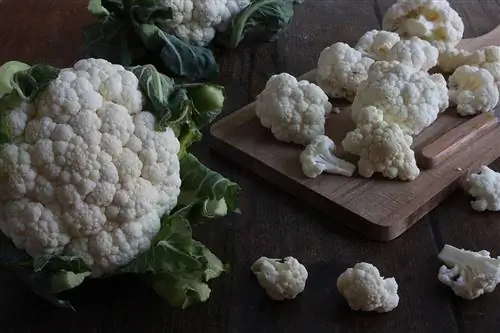
When is cauliflower no longer edible?
If stored incorrectly or for too long, some characteristics can indicate deterioration. There is often a strong, musty smell. The consistency also changes gradually. The rich white gives way to yellow, the leaves lose color and detach from the stem. Such cabbage is no longer suitable for consumption. If there is bad cabbage in the refrigerator, it is advisable to disinfect it so that mold spores that may be in the food compartment do not spread to other vegetables.
The vegetables should be disposed of if they have the following characteristics:
- Strong smell
- Dark spots on the florets
- Yellowish hue
- Falling Leaves
- Soggy consistency
Info:
In principle, ripening is not necessary for these flowering vegetables. Vegetables that do not ripen should never be stored together with vegetables that do ripen, as their shelf life is drastically shortened.

